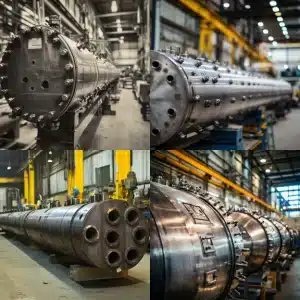
Metallurgical failure analysis uncovers why pressure vessels and industrial equipment fail by combining the metallurgical testing process, structured inspections, lab testing, and root cause analysis to guide design improvements. At Red River LLC, integrating software modeling and Lean Sigma principles with prefabrication ensures regulatory compliance, reduces hazards, and extends the service life of components while preventing repeated failures and optimizing industrial equipment performance.
Step-by-step Guide on How is Metallurgical Failure Analysis Done
When you rely on pressure vessels or other industrial equipment, you might wonder how is metallurgical failure analysis done to prevent unexpected breakdowns.The metallurgical testing process makes this task more straightforward than it seems when framed with clear steps, reliable data, and an experienced partner. Although every industry has variations in materials and operational environments, the core principles of failure analysis remain the same: identify the problem, study the evidence, and create a preventive strategy.
At Red River LLC, the team integrates advanced software modeling and Lean Sigma principles to shorten fabrication times and enhance reliability. Prefabrication is a major piece of that puzzle, because building components in a controlled environment can reduce on-site hazard hours and slash your total construction costs. When you see how each step of the metallurgical testing process fits into a bigger picture of safety, cost containment, and regulatory compliance, you will realize it is an essential tool for modern plant efficiency.
How is Metallurgical Failure Analysis Done?
Industrial equipment failure analysis relies on a structured path from initial observation to a final report. While you can fine-tune these steps for your own project, the following approach is widely accepted in industrial settings. For deeper insights, explore material failure analysis or what is metallurgical failure analysis. This approach helps identify root causes, prevent repeated breakdowns, and improve reliability, ensuring that industrial equipment operates safely and efficiently under all conditions.
Step 1: Define Your Analysis Goals
You begin by clarifying precisely what you need to learn. Sometimes, you might be investigating a part that cracked without warning. Other times, you want to confirm that a pressure vessel meets strict regulatory standards. Red River LLC typically starts by collecting design parameters, such as temperature ranges, operating pressures, and environmental conditions. For broader insights, refer to Industrial equipment failure analysis or pressure vessel failure analysis to see common causes in industrial equipment.
Step 2: Examine Material History
Many failures trace back to a mismatch between how a material was designed and how it is actually used. Checking specs and weld records and any prior repairs offers valuable context. At Red River LLC, detailed record-keeping is standard, ensuring each component is fully traceable and compliant with ASME guidelines. This approach supports Prefabrication in metallurgical testing, improving accuracy and efficiency in industrial inspections.
Step 3: Conduct Initial Inspections
Once your objectives and background data are clear, you proceed with inspections. Visual checks identify rust, dents, or cracks. Nondestructive testing like ultrasonic scanning or radiography detects hidden flaws without dismantling equipment. Early detection of flaws aligns with the prefabrication model to correct vulnerabilities in a controlled shop environment.
Step 4: Run Lab-based Tests
If nondestructive methods suggest deeper issues, lab testing is next. This may involve destructive tests to stress, impact, or chemically analyze a sample. Tools like scanning electron microscopy and chemical analysis confirm root causes like corrosion or fatigue. Specialized paths such as corrosion failure analysis or fatigue failure analysis reveal unique material breakdown conditions.
Step 5: Interpret and Implement Findings
After gathering data, synthesize observations into a timeline of how the failure occurred. This root cause analysis guides design modifications, material upgrades, and workflow improvements. Prefabrication in metallurgical testing tightens the loop between detection and production, enhancing the service life of components.
Step 6: Optimize Future Performance
The real value of metallurgical testing lies in continuous improvement. Refining training, upgrading inspections, and implementing Lean Sigma practices ensures safer, more reliable operations. Lessons from each project feed into better welds, designs, and prefabrication processes.
Recap: How is Metallurgical Failure Analysis Done
By defining precise goals, studying materials thoroughly, and running meticulous inspections, you uncover not just how a component failed but also why it failed. That knowledge informs design changes and process improvements, ensuring future operations run smoothly. Prefabrication strategies, like those championed at Red River, underscore how a controlled environment can cut costs, curb hazards, and make it simpler to adapt your findings into tangible solutions.
Whether you are dealing with a simple weld seam or an entire pressure vessel, the sequence remains consistent. You start with the data design criteria, usage logs, and any visible damage then dive deeper with nondestructive and destructive tests. Once you interpret your results, you put them into action by upgrading materials or improving your workflow. This blueprint helps you sidestep repeated breakdowns and capture the full service life of your equipment.
Ensure Equipment Reliability with Expert Metallurgical Failure Analysis
Protect your critical equipment and prevent costly failures partner with Red River LLC for expert metallurgical failure analysis. Request a consultation today to ensure your industrial operations run safely and efficiently.
Frequently Asked Questions
1. What is metallurgical failure analysis?
Metallurgical failure analysis is the study of metal components to determine why they failed or did not perform as expected.
2. Why is metallurgical failure analysis important?
Metallurgical failure analysis is important because it helps prevent repeat failures, improves safety, reduces downtime, and enhances the reliability of metal components.
3. Is nondestructive testing always enough to find flaws?
Not always. Nondestructive methods like ultrasonic or radiographic testing are excellent first steps, but if indications suggest deeper micro-cracks or chemical irregularities, more invasive testing may be necessary. In that case, a small sample is tested destructively in a lab to gather more precise data.
4. Can I combine metallurgical failure analysis with other testing approaches?
Yes. In fact, many experts recommend a multi-disciplinary approach. You might blend metallurgical testing with mechanical failure analysis or even structural failure analysis to confirm that your designs are robust. Each method offers unique insights into how materials behave under specific stresses, vibrations, or loads.
5. How often should metallurgical testing be repeated?
That depends on your operational demands, regulatory requirements, and past track record of failures. In some high-risk industries, an annual or semi-annual check is standard. Where usage is lighter, you might only need a thorough review every couple of years. Red River encourages consistent monitoring, especially if you notice unusual noises, pressure drops, or performance shifts.
6. Is it possible to skip destructive testing to save money?
While you can sometimes rely solely on nondestructive methods, skipping destructive tests might limit what you learn about the root cause. Everything hinges on your risk tolerance and the complexity of your equipment. Critical components, such as pressure vessels operating in harsh conditions, often benefit from a deeper lab examination to ensure a complete understanding of any flaws.
7. Does failure analysis always require an external consultant?
Not necessarily. Some companies maintain in-house teams, especially if they frequently work with complex equipment. However, external consultants bring specialized equipment, expertise, and certifications that can be difficult to replicate internally. Partnering with an accredited organization, such as one holding ASME and NBBI Stamp certifications, increases confidence in the test results.
Key Takeaways
- Define your analysis objectives early. By setting clear goals, you save time and target the most relevant tests.
- Combine multiple testing methods. Nondestructive exams plus destructive lab work give you a full picture of why a failure happened.
- Use traceable materials. Following ASME guidelines and verifying your raw materials can prevent mismatched alloys or flawed welds.
- Embrace prefabrication advantages. Controlled shop environments simplify inspections, reduce rework, and cut on-site risks.
- Integrate improvements into future builds. A strong feedback loop turns failure insights into better materials, welds, and designs moving forward.




